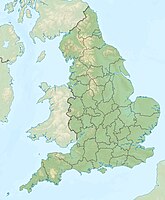High Peak (Devon)
| High peak | ||
 The High Peak cliff at Sidmouth |
||
| Geographical location | ||
|
|
||
| Coordinates | 50 ° 39 '58 " N , 3 ° 16' 18" W | |
| Waters 1 | English Channel | |
High Peak is a partially eroded cliff on the English Channel - coast near Sidmouth , Devon , in the south of England .
location
High Peak and Peak Hill are west of Sidmouth town, between Sidmouth and the village of Otterton . Sidmouth is 20 kilometers east of the city of Exeter , 14 kilometers south of Honiton and about 16 kilometers northeast of Exmouth .
The highest point of High Peak is 157 meters high.
On the edge of the cliff are the remains of earthworks that indicate settlement in the Iron Age , Ancient Roman Period and the Dark Ages . Archaeological research has shown that the earthworks extended several dozen meters into an area that is now eroded by the sea. A general interpretation of High Peak suggests that it was an Iron Age hill fort that found reuse in the Dark Ages, likely as a fortified trading post on the coast.
Jurassic Coast
The cliffs of High Peak are part of the so-called Jurassic Coast (see also: List of places along the Jurassic Coast ).
This coastline and the cliffs along East Devon and Dorset are among the most outstanding natural monuments in Europe. From Orcombe Point to Old Harry Rocks , east of Studland Bay , there is a 155-kilometer stretch of coastline, which was the first natural landscape in England to be declared a World Heritage Site by UNESCO .
The rock layers along the coast are sloping to the east. Therefore, the oldest part is in the western area, progressively younger rocks form the cliffs further east. The natural outcrops along the Jurassic Coast reveal a continuous sequence of geological deposits formed in the Triassic , Jurassic and Cretaceous periods and represent around 185 million years of geological history .
geology
There are four layer sequences along the coast below the High Peak. The otter sandstones form the base layer of the cliffs. These red sandstones come from a hot, dry climate in the Triassic around 220 million years ago. The debris in the middle of the rock face are Mercia Mudstones . The formations of the Mercia-mudstone group consist of different layers of claystone -, siltstone - and sandstone -Minerale. They were formed about 200 million years ago.
Above these Triassic formations there are deposits from the Cretaceous Period. The rock formations show layers of Upper Greensand that were formed about 80 million years ago.
The top of High Peak Hill is formed by flint gravel. This layer is likely a relic of the Cretaceous rocks that were washed away by erosion in the early Tertiary , about 60 to 65 million years ago.
There are a number of fossil sites along the Jurassic Coast . Fossils of various vertebrates (fish, reptiles and amphibians) from the Triassic Period have been found below the cliffs of High Peak Hill and Peak Hill .
Individual evidence
- ↑ RRSellman: Aspects of Devon History. Devon Books, 1985 ISBN 0861147561 (Chapter 2: The Iron Age in Devon. Map: page 11, Iron Age Hill Forts in Devon)
- ^ Dorset and East Devon Coast . UNESCO World Heritage Center. 2001. Retrieved October 19, 2010.
literature
- The Jurassic Coast Trust: A Walk Through Time, the Official Guide to the Jurassic Coast . Coastal Publishing, 2003, ISBN 978-0-9544845-0-7 .

